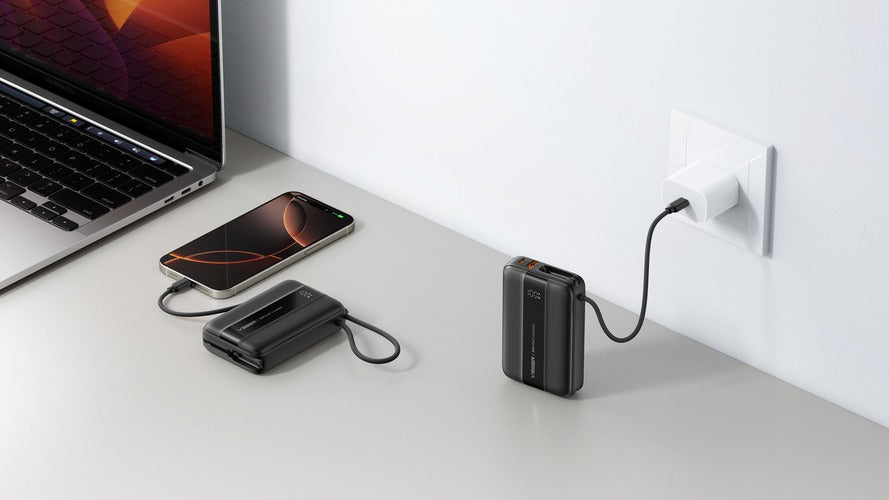You hit the power button. Nothing.
You try another cable. Still nothing.
Or maybe it does charge—but takes forever or gets hot.
Most people treat power banks like plug-and-play gadgets. But if you want faster charging, better battery life, and less frustration, learning how to charge a power bank properly is a must.
Whether you’re charging it for the first time or just want to avoid rookie mistakes, this guide has everything you need.
What to Know Before Charging a Power Bank
Before you plug in that cable, take a moment to understand your portable charger. Here are a few things that make a big difference:
First, check the input port type. Most power banks come with USB-C or micro-USB input. Some premium models also include Lightning input for Apple users.
Next, look at the input voltage and current. These are typically printed on the back or in the manual. Common ratings include 5V/2A, but fast-charging models may accept 9V/2A or even 12V/1.5A.
Capacity also plays a role. A compact 5,000mAh power bank will charge much faster than a 30,000mAh one. Charging time scales with size and input speed.
And don’t forget about your wall adapter. Laptop USB ports are weak—stick to a proper charger that matches the input requirements.
If you're still hunting for a reliable charger, Veger is a name worth knowing. Known for combining sleek design with power-packed performance, Veger offers a wide range of fast-charging, travel-friendly portable power banks. Built with smart chip protection and global safety certifications, Veger’s products are trusted by users in over 100 countries. With cutting-edge support for Quick Charge and Power Delivery, it's no wonder Veger is becoming the go-to for anyone who takes charging seriously.
How to Charge a Power Bank: Step-by-Step Guide
Let’s walk through how to charge your power bank from start to finish. Whether it’s your first time or you just want to improve your routine, these steps will help you charge smarter.
Step 1: Check how much power is left
Most power banks have LED lights or a small digital display to show the battery level. For LED lights:
- 1 blinking light = very low
- 2 lights = about 25–50%
- 3 = 50–75%
- 4 solid = fully charged
Checking the battery level first helps you avoid overcharging or charging when it’s not needed. It’s also helpful for spotting any problems early on.
Step 2: Plug into a wall charger (not your laptop)
Here’s where a lot of people slow themselves down. Plugging into your computer’s USB port may be convenient, but it delivers very little power. For faster and safer results, use a wall adapter—preferably one that supports 5V/2A or higher.
If your power bank supports fast charging, look for a charger that supports Quick Charge or USB Power Delivery. A higher-wattage charger can cut charging time in half.
Step 3: Use the right cable
It sounds basic, but this matters. If your power bank has a USB-C port, use a USB-C to USB-C cable for best performance. If it uses micro-USB, make sure your cable isn’t old, frayed, or low quality.
Many charging issues come down to using the wrong or worn-out cable. If you’re ever wondering how do you charge a power bank and it’s not working, try swapping the cable first.
Step 4: Watch the lights while charging
As your power bank charges, you’ll see the LED lights blink or the percentage climb. If nothing’s changing after 30–60 minutes, something’s wrong. Maybe the cable is loose, the charger isn’t working, or the power bank has overheated.
Once all lights are solid or the screen reads 100%, it’s time to unplug.
Step 5: Avoid using your power bank while it charges
You might be tempted to plug in your phone and top it up while your power bank is charging—but try not to. Unless the device specifically supports pass-through charging, doing this can generate extra heat and slow down the charging process.
If you’re wondering how to use a power bank to charge a phone while charging the power bank itself, it’s possible on some models, but it’s generally better to let the power bank finish charging first.
Step 6: Unplug when it’s done
Many power banks automatically stop charging when full. Still, it’s good practice to unplug once it reaches 100% to avoid unnecessary heat buildup or stress on the battery. This is especially true if you're using older adapters or charging overnight.
Step 7: Store it safely
Once fully charged, store your power bank in a cool, dry place—preferably with a charge level between 40% and 80%. Avoid leaving it in extreme temperatures (like inside a hot car), and don’t store it completely empty or fully charged for long periods.
These small habits can extend battery health significantly.
How to Charge Power Bank for the First Time
If it’s your first time figuring out how to charge power bank for the first time, here’s what to do:
- Don’t assume it’s fully charged out of the box. Most power banks ship at 40–60% charge for safety.
- Use the original cable and a quality adapter. First-time charging helps calibrate internal battery management systems.
- Charge to full. Allow the unit to charge to 100% before its first use. This is especially important for lithium-ion power banks.
- Avoid using it during the initial charge. Give it time to build its baseline performance.
How to Charge a Power Bank Faster without Damaging It
Use a high-output adapter that matches your power bank's input specs. If the label says 9V/2A or 12V/1.5A, you'll need a fast charger that supports USB Power Delivery or Quick Charge—preferably 18W or higher.
Then, choose a fast-charging capable cable. USB-C to USB-C cables for PD, or micro-USB cables rated for 2A+, are ideal. A bad cable slows everything down.
Also, pay attention to temperature. Batteries charge better in cool environments. Avoid sunlight, beds, or tight spaces where heat builds up.
Lastly, don’t charge your phone from the power bank while it’s recharging. It adds stress and slows down both charging processes.
How to Know When a Power Bank is Fully Charged
Most power banks come with four LED lights that gradually light up as the battery fills, or a digital screen that displays a percentage. So, how do you know when your power bank is fully charged? When all LEDs are solid (not blinking), or the screen reads 100%, it’s done.
But here’s a situation that confuses many users: the LED shows full, yet the power bank keeps charging. Why?
In many cases, that’s due to trickle-charging behavior. Some models continue to draw tiny amounts of power even after reaching full charge—either to balance the cells or because the charger doesn’t automatically shut off. While this isn’t dangerous, it’s not ideal to leave it charging for too long.
If your power bank still seems to be charging after several hours, and the lights or screen show 100%, go ahead and unplug it. It’s better to be safe than sorry—and it helps preserve long-term battery life.
Learn more: How Long Does It Take to Charge a Power Bank
What to Check If a Power Bank Is Not Charging
When a power bank refuses to charge, try these steps:
- Swap the cable and adapter: Most issues are caused by low-quality or damaged cables.
- Clean the input port: Dust or lint buildup can block connections. Use a soft brush or compressed air.
- Let it cool down: Overheating may trigger safety shutdown. Give it 30 minutes to recover.
- Try another power source: Test a different outlet or USB port.
- Reset the power bank: Some models reset by holding the power button for 10 seconds.
Still stuck? If under warranty, contact the manufacturer.
FAQ about How to Charge a Power Bank
Can I charge and use the power bank at the same time?
Some power banks support pass-through charging, which allows simultaneous charging and discharging. But not all do—and even when supported, it can generate more heat and slow everything down. If you can, avoid it.
Is it okay to leave my power bank charging overnight?
Most modern power banks have auto shut-off features when full. That said, consistently leaving them plugged in for 8+ hours can shorten battery life over time. It’s better to unplug when charging is done.
Can I use my phone while charging the power bank?
Yes, but your phone won’t draw power from the power bank—it’ll continue draining its own battery. If the power bank isn’t already charged, using your phone won’t help.
Is it bad to fully discharge a power bank?
Yes. Lithium-ion batteries don’t like being drained to 0%. Try to recharge when it hits 20–30%, and avoid leaving it empty for long periods.
Conclusion
Knowing how to charge a power bank isn't rocket science—but it is the difference between a dependable device and a dead one when you need it most.
Want faster charging? Longer lifespan? Stylish, powerful designs?
Check out Veger. Our power banks combine sleek portability with fast-charging tech—built for everyday use, travel, and emergencies alike.
So whether you're wondering how to use a power bank to charge a phone or how to charge power bank without charger, Veger’s got your back—with safe, smart solutions that just work.

![How to Charge a Power Bank in 2025 [Fast and Safe]](http://www.vegerpower.com/cdn/shop/articles/how-to-charge-power-bank.jpg?v=1750921525&width=1500)


